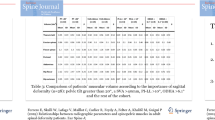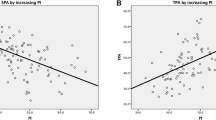Abstract
Purpose
To clarify the relationship between sarcopenia and spinopelvic parameters.
Methods
Among outpatients of spine surgery department, 126 patients (mean age 77.2 years. M/F = 71/55) were included. We diagnosed patients with sarcopenia using the diagnostic algorithm of the Asian Working Group for Sarcopenia. Spinopelvic parameters and the prevalence of spinopelvic mismatch (pelvic incidence minus lumbar lordosis ≥ 10°) were investigated and compared between patients with and without sarcopenia. Furthermore, we compared the spinopelvic parameters between the Sarcopenia and No Sarcopenia groups under each condition of spinopelvic match and mismatch.
Results
The prevalence of sarcopenia in this study was 21.4%. Overall, the spinopelvic parameters except thoracic kyphosis (TK) (Sarcopenia: 34.7°, No Sarcopenia: 24.3°, p < 0.01) were not significantly different between the Sarcopenia and No Sarcopenia groups. Prevalence of patients with spinopelvic mismatch was also not significantly different between the Sarcopenia and No Sarcopenia groups (37.0% vs. 42.4%, p = 0.66). Among patients without spinopelvic mismatch, there was no spinopelvic parameter with a significant difference between the 2 groups. However, among patients with spinopelvic mismatch, sagittal vertebral axis (SVA) (115.7 mm vs. 58.7 mm, p < 0.01) and TK (36.6° vs. 21.3°, p < 0.01) of the Sarcopenia group were significantly larger than those of the No Sarcopenia group. Moreover, sarcopenia was independently related to a significant increase in SVA (β = 50.7, p < 0.01) and TK (β = 14.0, p < 0.01) in patients with spinopelvic mismatch, after adjustment for age.
Conclusions
Sarcopenia is related to spinal sagittal imbalance because of insufficient compensation by flattening thoracic kyphosis in patients with spinopelvic mismatch.
Graphic abstract
These slides can be retrieved under Electronic Supplementary Material.





Similar content being viewed by others
References
Rosenberg IH (1997) Sarcopenia: origins and clinical relevance. J Nutr 127:990S–991S. https://doi.org/10.1093/jn/127.5.990S
Trombetti A, Reid KF, Hars M, Herrmann FR, Pasha E, Phillips EM, Fielding RA (2016) Age-associated declines in muscle mass, strength, power, and physical performance: impact on fear of falling and quality of life. Osteoporos Int 27:463–471. https://doi.org/10.1007/s00198-015-3236-5
Brown JC, Harhay MO, Harhay MN (2016) Sarcopenia and mortality among a population-based sample of community-dwelling older adults. J Cachexia Sarcopenia Muscle 7:290–298. https://doi.org/10.1002/jcsm.12073
Cruz-Jentoft AJ, Baeyens JP, Bauer JM, Boirie Y, Cederholm T, Landi F, Martin FC, Michel JP, Rolland Y, Schneider SM, Topinkova E, Vandewoude M, Zamboni M, European Working Group on Sarcopenia in Older P (2010) Sarcopenia: European consensus on definition and diagnosis: report of the European Working Group on Sarcopenia in Older People. Age Ageing 39:412–423. https://doi.org/10.1093/ageing/afq034
Chen LK, Liu LK, Woo J, Assantachai P, Auyeung TW, Bahyah KS, Chou MY, Chen LY, Hsu PS, Krairit O, Lee JS, Lee WJ, Lee Y, Liang CK, Limpawattana P, Lin CS, Peng LN, Satake S, Suzuki T, Won CW, Wu CH, Wu SN, Zhang T, Zeng P, Akishita M, Arai H (2014) Sarcopenia in Asia: consensus report of the Asian Working Group for Sarcopenia. J Am Med Dir Assoc 15:95–101. https://doi.org/10.1016/j.jamda.2013.11.025
Lee DW, Choi EY (2016) Sarcopenia as an independent risk factor for decreased BMD in COPD patients: Korean National Health and Nutrition Examination Surveys IV and V (2008–2011). PLoS ONE 11:e0164303. https://doi.org/10.1371/journal.pone.0164303
Wang T, Feng X, Zhou J, Gong H, Xia S, Wei Q, Hu X, Tao R, Li L, Qian F, Yu L (2016) Type 2 diabetes mellitus is associated with increased risks of sarcopenia and pre-sarcopenia in Chinese elderly. Sci Rep 6:38937. https://doi.org/10.1038/srep38937
Han P, Yu H, Ma Y, Kang L, Fu L, Jia L, Chen X, Yu X, Hou L, Wang L, Zhang W, Yin H, Niu K, Guo Q (2017) The increased risk of sarcopenia in patients with cardiovascular risk factors in Suburb-Dwelling older Chinese using the AWGS definition. Sci Rep 7:9592. https://doi.org/10.1038/s41598-017-08488-8
Souza VA, Oliveira D, Barbosa SR, Correa J, Colugnati FAB, Mansur HN, Fernandes N, Bastos MG (2017) Sarcopenia in patients with chronic kidney disease not yet on dialysis: analysis of the prevalence and associated factors. PLoS ONE 12:e0176230. https://doi.org/10.1371/journal.pone.0176230
Hida T, Shimokata H, Sakai Y, Ito S, Matsui Y, Takemura M, Kasai T, Ishiguro N, Harada A (2016) Sarcopenia and sarcopenic leg as potential risk factors for acute osteoporotic vertebral fracture among older women. Eur Spine J 25:3424–3431. https://doi.org/10.1007/s00586-015-3805-5
Park S, Kim HJ, Ko BG, Chung JW, Kim SH, Park SH, Lee MH, Yeom JS (2016) The prevalence and impact of sarcopenia on degenerative lumbar spinal stenosis. Bone Joint J 98-B:1093–1098. https://doi.org/10.1302/0301-620X.98B8.37623
Glassman SD, Bridwell K, Dimar JR, Horton W, Berven S, Schwab F (2005) The impact of positive sagittal balance in adult spinal deformity. Spine (Phila Pa 1976) 30:2024–2029
Diebo BG, Ferrero E, Lafage R, Challier V, Liabaud B, Liu S, Vital JM, Errico TJ, Schwab FJ, Lafage V (2015) Recruitment of compensatory mechanisms in sagittal spinal malalignment is age and regional deformity dependent: a full-standing axis analysis of key radiographical parameters. Spine (Phila Pa 1976) 40:642–649. https://doi.org/10.1097/BRS.0000000000000844
Sinaki M, Itoi E, Rogers JW, Bergstralh EJ, Wahner HW (1996) Correlation of back extensor strength with thoracic kyphosis and lumbar lordosis in estrogen-deficient women. Am J Phys Med Rehabil 75:370–374
Katzman WB, Miller-Martinez D, Marshall LM, Lane NE, Kado DM (2014) Kyphosis and paraspinal muscle composition in older men: a cross-sectional study for the Osteoporotic Fractures in Men (MrOS) research group. BMC Musculoskelet Disord 15:19. https://doi.org/10.1186/1471-2474-15-19
Eguchi Y, Suzuki M, Yamanaka H, Tamai H, Kobayashi T, Orita S, Yamauchi K, Suzuki M, Inage K, Fujimoto K, Kanamoto H, Abe K, Aoki Y, Toyone T, Ozawa T, Takahashi K, Ohtori S (2017) Associations between sarcopenia and degenerative lumbar scoliosis in older women. Scoliosis Spinal Disord 12:9. https://doi.org/10.1186/s13013-017-0116-0
Cesari M, Kritchevsky SB, Newman AB, Simonsick EM, Harris TB, Penninx BW, Brach JS, Tylavsky FA, Satterfield S, Bauer DC, Rubin SM, Visser M, Pahor M (2009) Added value of physical performance measures in predicting adverse health-related events: results from the Health, Aging And Body Composition Study. J Am Geriatr Soc 57:251–259. https://doi.org/10.1111/j.1532-5415.2008.02126.x
Baumgartner RN, Koehler KM, Gallagher D, Romero L, Heymsfield SB, Ross RR, Garry PJ, Lindeman RD (1998) Epidemiology of sarcopenia among the elderly in New Mexico. Am J Epidemiol 147:755–763
Legaye J, Duval-Beaupere G, Hecquet J, Marty C (1998) Pelvic incidence: a fundamental pelvic parameter for three-dimensional regulation of spinal sagittal curves. Eur Spine J 7:99–103
Schwab F, Lafage V, Boyce R, Skalli W, Farcy JP (2006) Gravity line analysis in adult volunteers: age-related correlation with spinal parameters, pelvic parameters, and foot position. Spine (Phila Pa 1976) 31:E959–E967. https://doi.org/10.1097/01.brs.0000248126.96737.0f
Vialle R, Levassor N, Rillardon L, Templier A, Skalli W, Guigui P (2005) Radiographic analysis of the sagittal alignment and balance of the spine in asymptomatic subjects. J Bone Jt Surg Am 87:260–267. https://doi.org/10.2106/JBJS.D.02043
Schwab F, Patel A, Ungar B, Farcy JP, Lafage V (2010) Adult spinal deformity-postoperative standing imbalance: how much can you tolerate? An overview of key parameters in assessing alignment and planning corrective surgery. Spine (Phila Pa 1976) 35:2224–2231. https://doi.org/10.1097/BRS.0b013e3181ee6bd4
Bess S, Schwab F, Lafage V, Shaffrey CI, Ames CP (2013) Classifications for adult spinal deformity and use of the Scoliosis Research Society-Schwab Adult Spinal Deformity Classification. Neurosurg Clin N Am 24:185–193. https://doi.org/10.1016/j.nec.2012.12.008
Yoshimura N, Muraki S, Oka H, Iidaka T, Kodama R, Kawaguchi H, Nakamura K, Tanaka S, Akune T (2017) Is osteoporosis a predictor for future sarcopenia or vice versa? Four-year observations between the second and third ROAD study surveys. Osteoporos Int 28:189–199. https://doi.org/10.1007/s00198-016-3823-0
Lafage V, Schwab F, Patel A, Hawkinson N, Farcy JP (2009) Pelvic tilt and truncal inclination: two key radiographic parameters in the setting of adults with spinal deformity. Spine (Phila Pa 1976) 34:E599–E606. https://doi.org/10.1097/BRS.0b013e3181aad219
Barrey C, Roussouly P, Perrin G, Le Huec JC (2011) Sagittal balance disorders in severe degenerative spine. Can we identify the compensatory mechanisms? Eur Spine J 20(Suppl 5):626–633. https://doi.org/10.1007/s00586-011-1930-3
Smith JS, Lafage V, Shaffrey CI, Schwab F, Lafage R, Hostin R, O'Brien M, Boachie-Adjei O, Akbarnia BA, Mundis GM, Errico T, Kim HJ, Protopsaltis TS, Hamilton DK, Scheer JK, Sciubba D, Ailon T, Fu KM, Kelly MP, Zebala L, Line B, Klineberg E, Gupta M, Deviren V, Hart R, Burton D, Bess S, Ames CP, International Spine Study G (2016) Outcomes of operative and nonoperative treatment for adult spinal deformity: a prospective, multicenter, propensity-matched cohort assessment with minimum 2-year follow-up. Neurosurgery 78:851–861. https://doi.org/10.1227/NEU.0000000000001116
Smith JS, Shaffrey CI, Klineberg E, Lafage V, Schwab F, Lafage R, Kim HJ, Hostin R, Mundis GM Jr, Gupta M, Liabaud B, Scheer JK, Diebo BG, Protopsaltis TS, Kelly MP, Deviren V, Hart R, Burton D, Bess S, Ames CP, Group obotISS (2017) Complication rates associated with 3-column osteotomy in 82 adult spinal deformity patients: retrospective review of a prospectively collected multicenter consecutive series with 2-year follow-up. J Neurosurg Spine 27:444–457. https://doi.org/10.3171/2016.10.SPINE16849
Yagi M, Ames CP, Keefe M, Hosogane N, Smith JS, Shaffrey CI, Schwab F, Lafage V, Shay Bess R, Matsumoto M, Watanabe K, International Spine Study G (2018) A cost-effectiveness comparisons of adult spinal deformity surgery in the United States and Japan. Eur Spine J 27:678–684. https://doi.org/10.1007/s00586-017-5274-5
Eguchi Y, Toyoguchi T, Inage K, Fujimoto K, Orita S, Yamauchi K, Suzuki M, Kanamoto H, Abe K, Norimoto M, Umimura T, Koda M, Furuya T, Aoki Y, Takahashi K, Ohtori S (2018) Pentosidine concentration is associated with degenerative lumbar scoliosis in older women: preliminary results. Eur Spine J 27:597–606. https://doi.org/10.1007/s00586-017-5370-6
Koshimizu H, Sakai Y, Harada A, Ito S, Ito K, Hida T (2018) The impact of sarcopenia on cervical spine sagittal alignment after cervical laminoplasty. Clin Spine Surg 31:E342–e346. https://doi.org/10.1097/bsd.0000000000000657
Ilharreborde B, Steffen JS, Nectoux E, Vital JM, Mazda K, Skalli W, Obeid I (2011) Angle measurement reproducibility using EOS three-dimensional reconstructions in adolescent idiopathic scoliosis treated by posterior instrumentation. Spine (Phila Pa 1976) 36:E1306–E1313. https://doi.org/10.1097/BRS.0b013e3182293548
Obeid I, Hauger O, Aunoble S, Bourghli A, Pellet N, Vital JM (2011) Global analysis of sagittal spinal alignment in major deformities: correlation between lack of lumbar lordosis and flexion of the knee. Eur Spine J 20(Suppl 5):681–685. https://doi.org/10.1007/s00586-011-1936-x
Author information
Authors and Affiliations
Corresponding author
Ethics declarations
Conflict of interest
The authors declare that they have no conflict of interest.
Ethical approval
The study protocol was approved by the Institutional Review Board of our institution (No. 3170).
Additional information
Publisher's Note
Springer Nature remains neutral with regard to jurisdictional claims in published maps and institutional affiliations.
Electronic supplementary material
Below is the link to the electronic supplementary material.
Rights and permissions
About this article
Cite this article
Ohyama, S., Hoshino, M., Terai, H. et al. Sarcopenia is related to spinal sagittal imbalance in patients with spinopelvic mismatch. Eur Spine J 28, 1929–1936 (2019). https://doi.org/10.1007/s00586-019-06066-2
Received:
Revised:
Accepted:
Published:
Issue Date:
DOI: https://doi.org/10.1007/s00586-019-06066-2




